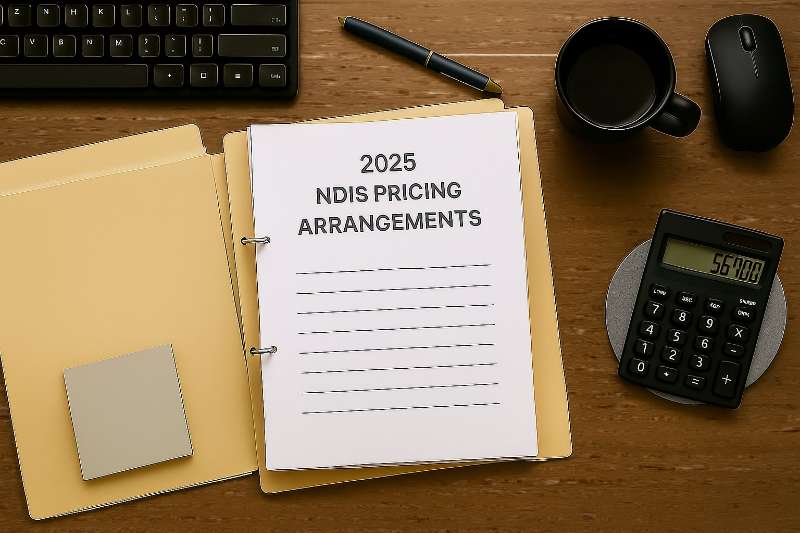In this article, we’ll discover how the 2025 NDIS Pricing Arrangements & Price Limits impact SDA housing investments. Learn about pricing changes, challenges for providers, and what it means for investors in this article.
As an NDIS property provider, it’s essential to stay on top of the latest developments in 2025 NDIS pricing arrangements and price limits. Changes and updates in these pricing arrangements can have a significant impact on your investment in Specialist Disability Accommodation (SDA) housing. Understanding how these changes affect the NDIS market, your business, and your property investments is critical for investors.
Challenges with 2025 NDIS Pricing Arrangements: What Are the Key Changes?
The NDIS pricing arrangements are reviewed annually and have significant implications for providers and investors alike. In 2025, we will see limited or no increases for several critical sectors, including support coordinators, plan managers, and allied health professionals. The pricing limits for these roles have remained stagnant, and in some cases, they have been reduced.
For example, support coordinators and plan managers have faced a freeze in the prices they are paid, despite rising operational costs such as wages, utilities, and general business expenses. This trend has persisted for years, leaving many providers struggling to maintain profitability. As a result, we have seen a noticeable increase in business closures within these sectors.
For SDA investors, this is a positive signal. It means the system is intensifying its focus on essential, high-impact services. SDA dwellings are a fundamental pillar of these essentials. This environment rewards investors who partner with efficient, high-quality providers who can deliver excellent participant outcomes even within an evolving framework. It separates transient operators from the serious, long-term players, creating a more stable and professional market.
Impact of Pricing Cuts on Allied Health Providers
The 2025 pricing updates have also been hard on allied health professionals such as physiotherapists, dietitians, and occupational therapists. These professionals have faced cuts in their hourly rates, which reduces the financial viability of delivering high-quality care.
Moreover, the NDIS has removed regional and remote loadings and reduced the funding for travel time. These cuts make it increasingly difficult for allied health providers to travel to remote locations and deliver therapy in the natural environment of the participant. Therapy delivered in the participant's home or school is far more effective, but now, with reduced funding for travel, providers are reconsidering whether it's worth continuing in the NDIS space.
This makes your SDA property’s location and design more important than ever. Properties that are easily accessible, close to community amenities and health services, and designed to facilitate in-home care delivery become not just preferable, but paramount. This trend doesn't diminish SDA's value; it elevates it, making premium, strategically located properties the most sought-after assets in the market.
NDIS's Shift: The Potential Phasing Out of Support Coordination and Plan Management
A concerning trend in the NDIS sector is the possibility of phasing out support coordination and plan management. Many expert NDIS consultants believe that the NDIS intends to reduce the role of support coordinators and plan managers, replacing them with a more automated, centralised approach. The NDIS is developing a new system with the aim of replacing support coordinators with navigators, a role potentially aligned with the Local Area Coordinators (LACs).
This shift could have a profound impact on how participants access support and navigate the system. With navigators taking over, the personalised support that participants receive could diminish, affecting their ability to manage and optimise their plans. Furthermore, the NDIS might not fund as generously as support coordinators currently do, which could result in less funding for participants and ultimately affect the demand for SDA housing.
For investors, this means the fundamental driver of demand for SDA remains unchanged: the NDIS is funded to provide eligible participants with a home that meets their needs. The process of how they connect with that home may be refined, but the necessity for the home itself is irrefutable and growing. This evolution encourages investors to ensure their properties are easy to understand, market, and match to participant needs.
Transitioning to a Medicare-Style System: The NDIS's Long-Term Plans
There has been ongoing discussion about transforming the NDIS into a Medicare-style system. While Medicare has had years to mature and establish robust systems, the NDIS is still evolving. Critics argue that while the concept of a Medicare-like approach for the NDIS could streamline services, it could also risk losing the person-centered approach that has made the NDIS unique.
If the NDIS transitions to a Medicare system, it could mean that participants are treated more like patients within a standardised care model. While this might reduce complexity and streamline processes, it could lead to less flexibility in addressing the unique needs of participants. For SDA investors, this could translate into lower demand for highly specialised housing, as fewer accommodations may be considered "necessary" under a more standardised system.
Standardisation does not mean a reduction in specialised housing needs. Instead, it promises a more predictable, transparent environment for your investment. The NDIS's commitment to providing for participants with complex needs ensures that appropriately designed SDA will always be a critical and funded component of the scheme, safeguarding your investment against market volatilities that affect other asset classes.
Impact on SIL Providers and the One-to-Three Ratio Model
The Supported Independent Living (SIL) sector is also facing significant challenges due to the 2025 NDIS pricing changes. SIL providers are struggling with the flawed design of the Disability Worker Cost Model, which has incentivised the NDIS to push for one-to-three ratios (one support worker for three participants).
For high-needs participants, such as those with complex disabilities, this shift is problematic. Many providers are unable to deliver the level of support required for these participants under a one-to-three model, which poses serious risks to participant safety and provider viability. This issue has led to some providers either absorbing the costs themselves or failing to meet participant needs, which can result in reduced occupancy rates or providers closing their doors altogether.
As SIL providers adapt to new efficiency models, the importance of a well-designed home that reduces support costs and enhances independent living becomes incredibly valuable. Your SDA investment, particularly in designs that promote autonomy and safety, directly helps providers operate effectively. This synergy makes your property a solution, not a problem, ensuring high demand and tenant retention.
The Role of Payment Freezes and Locks: Impact on Cash Flow
An additional concern for SDA providers is the payment freezes and payment locks that have been implemented by the NDIA. These measures are used when the NDIA suspects an issue with a payment claim or is investigating a provider. However, they have become increasingly common and have caused severe cash flow issues for many SDA providers.
The problem with payment locks is that they can occur randomly, and there’s no clear timeline for resolution. Providers may have to wait months before receiving payments for services already delivered. This can make it difficult for SDA providers to maintain financial stability, particularly when they are relying on timely payments to meet operational costs.
By partnering with a reputable, compliant, and financially stable SDA provider, you insulate yourself from these operational challenges. Top-tier providers have the experience and systems to navigate administration smoothly, ensuring consistent cash flow and protecting your returns. This environment rewards due diligence and strong partnerships.
Provider and Participant Well-being: The Bigger Picture
As the NDIS pricing arrangements and systemic changes evolve, it’s crucial to remember that these adjustments ultimately impact providers, participants, and investors alike. If providers are unable to sustain their businesses, it could lead to service gaps that directly affect participants’ quality of life. In turn, these disruptions can affect the overall NDIS property market.
For the strategic SDA investor, this means:
Quality and location are paramount.
Partnering with a top-tier provider is non-negotiable.
The long-term fundamentals of demand are stronger than ever.
Conclusion
In 2025, the NDIS pricing arrangements and price limits have posed several challenges for support coordinators, plan managers, allied health professionals, and SIL providers. These changes have made it harder for providers to maintain profitable businesses and have placed additional financial strain on the sector. For SDA housing investors, understanding these changes is crucial to making informed investment decisions. The potential shift towards a Medicare-style system, the increased difficulty for SIL providers, and the payment freezes are all factors that could impact the stability and profitability of your investment. By staying informed about these challenges and working closely with reliable providers, you can better navigate the evolving NDIS landscape and ensure that your investment in SDA housing remains sustainable in the long run.



































